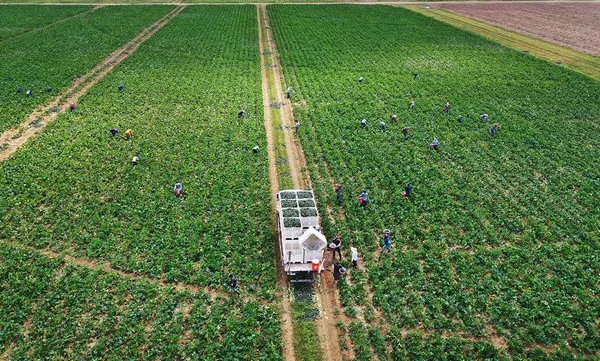JINAN, June 19 — In the heart of Shandong province, a pivotal region for wheat production in China, the fields are bustling with activity. Operators meticulously steer harvesters through expansive wheat fields, swiftly transforming seas of golden crops into neatly trimmed stubble within minutes.
Guo Bobo, a prominent grain producer overseeing operations in Wenshang County, marvels at the abundance: “Our granaries are already full, yet trucks continue to arrive with more grain.” Guo’s fields have achieved a record average yield of 9,750 kilograms per hectare.
This bustling scene is emblematic of China’s peak summer harvest, a period that typically spans from May to late June, marking the busiest and most rewarding time for farmers across the country.
Bumper Harvest
According to data from the Ministry of Agriculture and Rural Affairs, as of June 15, China had harvested approximately 310 million mu (about 20.68 million hectares) of winter wheat, with harvesting progress surpassing 90 percent.
Major wheat-producing provinces like Sichuan and Hubei have already completed their harvests. In Shandong, the second-largest wheat producer in China, 98.2 percent of its 60.54 million mu of wheat fields have been harvested as of Sunday.
Shandong’s total grain production has remained stable, exceeding 55 billion kilograms for three consecutive years. This year, both wheat yields and total production are expected to reach unprecedented levels, according to Yang Wujie from the provincial department of agriculture and rural affairs.
Throughout the summer, key winter wheat producing regions in China have maintained stable or slightly increased planting areas, with overall crop growth conditions better than average, providing a solid foundation for a successful summer harvest, as per the ministry’s reports.
Investments in Agricultural Infrastructure
Behind these achievements lies China’s concerted effort to enhance rural infrastructure, develop high-standard farmlands, and invest in advanced grain seed technologies through scientific research.
In Shandong alone, nearly 76.43 million mu of high-standard farmland have been cultivated, covering approximately 80 percent of the province’s total cultivated land and 90 percent of permanent basic cropland, according to Yang.
Li Genying, a researcher at the Crop Research Institute of the Shandong Academy of Agricultural Sciences, emphasized that China’s strategy of ‘field storage and technological advancement’ is fundamental in ensuring food production capabilities.
Technological Advancements
China has made significant strides in agricultural technology, particularly in salt-tolerant wheat varieties. Liu Luxiang, a researcher at the Institute of Crop Sciences, Chinese Academy of Agricultural Sciences, highlighted progress with over 700 new lines and 52 approved varieties currently being tested for salt-alkali tolerance. These advancements show promising potential to boost stable and higher yields, thereby enhancing overall grain production capacity.
Global Food Security
Amid global concerns over food prices, China’s role as the world’s largest food producer and third-largest food exporter becomes increasingly pivotal. The United Nations Food and Agriculture Organization (FAO) reported on June 7 that global wheat export prices have risen, reflecting worries about lower yields due to adverse crop conditions in major producing regions such as North America and Europe.
China’s grain output, which reached a record high of 695.41 million tonnes in 2023, underscores its substantial contribution to global food security and price stability. Yuan Liang, a researcher at the Chinese Academy of Agricultural Sciences, emphasized China’s commitment to feeding its population while supporting global food stability through domestically produced food.
Yuan noted, “By averting potential fluctuations in international food prices through substantial domestic production, China plays a crucial role in stabilizing global food supply.”
In summary, China’s robust summer harvest not only ensures ample domestic food supply but also contributes significantly to global food security, mitigating risks of food price volatility on the international stage.
Related Topics:
























